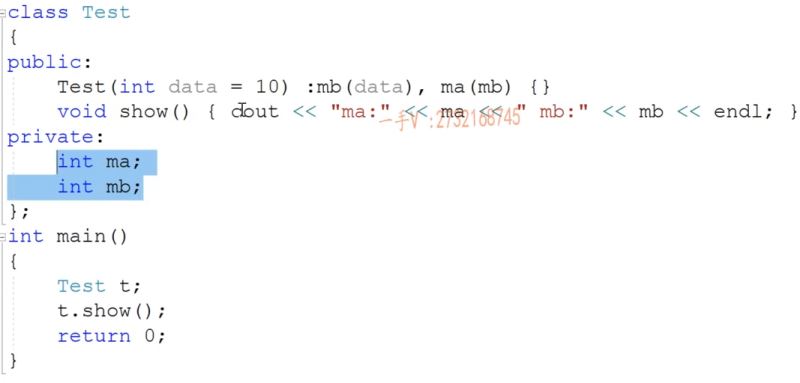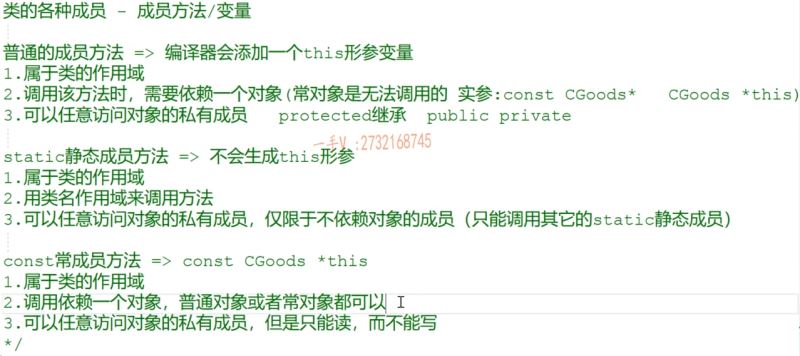C++类和对象的原理
woden 人气:0一、类和对象、this指针

OOP语言的四大特征是什么?
- 抽象
- 封装、隐藏
- 继承
- 多态
类体内实现的方法会自动处理为inline函数。
类对象的内存大小之和成员变量有关
类在内存上需要对齐,是为了减轻cup在内存上的io次数
查看类对象的大小的指令:cl className.cpp /d1reportSingleClassLayout类名
一个类可以定义无数个对象,每个对象都有自己的成员变量,但是他们共享一套成员方法。
有一个问题:Q1:类中的成员方法是怎么知道要处理哪个对象的信息的?
A1:在调用成员方法的时候会在参数列表里隐式的给定对象内存的地址。如下所示:

类的成员方法一经编译,所有方法参数都会加一个this指针,接收调用该方法的对象的地址,即下图中的CGoods *this

二、掌握构造函数和析构函数
定义一个SeqStack类:
class SeqStack
{
public:
SeqStack(int size = 10) :_top(-1), _size(size) {
_pstack = new int[size];
}
~SeqStack() {
cout << this << "~SeqStack()" << endl;
delete[] _pstack;
_pstack = nullptr;
}
void push(int val) {
if (full()) {
resize();
}
_pstack[++_top] = val;
}
void pop() {
if (empty()) {
return;
}
--_top;
}
int top() {
return _pstack[_top];
}
bool empty() { return _top == -1; }
bool full() { return _top == _size-1; }
private:
int* _pstack;
int _top;
int _size;
void resize() {
int* ptmp = new int[_size * 2];
for (int i = 0; i < _size; i++) {
ptmp[i] = _pstack[i];
}
delete[] _pstack;
_pstack = ptmp;
_size *= 2;
}
};
/**
运行过程
*/
int main() {
SeqStack sq1;
for (int i = 0; i < 15; i++) {
sq1.push(rand() % 100);
}
while (!sq1.empty()) {
cout << sq1.top() << " ";
sq1.pop();
}
return 0;
}
三、掌握对象的深拷贝和浅拷贝
.data段的对象是程序启动的时候构造的,程序结束的时候析构的
heap堆上对象是new的时候构造的,delete的时候析构的
stack栈上的对象是在调用函数的时候构造的,执行完函数时析构的
如果对象占用外部资源,浅拷贝就会出现问题:会导致一个对象指向的内存释放,从而造成另一个对象中的指针成为野指针。所以就要对这样的对象进行深拷贝,在新的对象中重新开辟一块空间,使两者互不干涉。
注意:在面向对象中,要避免使用memcpy进行拷贝,因为对象的内存占用不确定,会因为对象中保存指针而造成浅拷贝。需要拷贝的时候只能用for循环逐一拷贝。
深拷贝:
SeqStack& operator=(const SeqStack& src) {
cout << "operator=" << endl;
//防止自赋值
if (this == &src) {
return *this;
}
delete[] _pstack;//需要释放掉自身占用的外部资源
_pstack = new int[src._size];
for (int i = 0; i <= src._top; i++) {
_pstack[i] = src._pstack[i];
}
_top = src._top;
_size = src._size;
return *this;
}
SeqStack(const SeqStack& src) {
cout << this << "SeqStack(const SeqStack& src)" << endl;
_pstack = new int[src._size];
for (int i = 0; i <= src._top; i++) {
_pstack[i] = src._pstack[i];
}
_top = src._top;
_size = src._size;
}
四、类和对象应用实践
类Queue:
#pragma once
class CirQueue
{
public:
CirQueue(int size = 10) {
_pQue = new int[size];
_front = _rear = 0;
_size = size;
}
CirQueue(const CirQueue& src) {
_size = src._size;
_front = src._front;
_rear = src._rear;
_pQue = new int[_size];
for (int i = _front; i != _rear; i = (i + 1) % _size) {
_pQue[i] = src._pQue[i];
}
}
~CirQueue() {
delete[] _pQue;
_pQue = nullptr;
}
CirQueue& operator=(const CirQueue& src) {
if (this == &src) {
return *this;
}
delete[] _pQue;//需要释放掉自身占用的外部资源
_size = src._size;
_front = src._front;
_rear = src._rear;
_pQue = new int[_size];
for (int i = _front; i != _rear; i = (i + 1) % _size) {
_pQue[i++] = src._pQue[i];
}
return *this;
}
void push(int val) {
if (full()) {
resize();
}
_pQue[_rear] = val;
_rear = (_rear + 1) % _size;
}
void pop() {
if (empty()) {
return;
}
_front = (_front + 1) % _size;
}
int front() {
return _pQue[_front];
}
bool full() {
return (_rear + 1) % _size == _front;
}
bool empty () {
return _front == _rear;
}
private:
int* _pQue;
int _front;
int _rear;
int _size;
void resize() {
int* ptmp = new int[_size * 2];
int index = 0;
for (int i = _front; i != _rear; i=(i+1)%_size) {
ptmp[index++] = _pQue[i];
}
delete[] _pQue;
_pQue = ptmp;
_front = 0;
_rear = index;
_size *= 2;
}
};类String:
#pragma once
#include <algorithm>
class String
{
public:
String(const char* str = nullptr) {
if (str != nullptr) {
_pChar = new char[strlen(str) + 1];
strcpy(_pChar, str);
}
else {
_pChar = new char[1];
*_pChar = '\0';
}
}
String(const String& str) {
_pChar = new char[strlen(str._pChar)+1];
strcpy(_pChar, str._pChar);
}
~String() {
delete[] _pChar;
_pChar = nullptr;
}
String& operator=(const String& str) {
if (this == &str) {
return *this;
}
delete[] _pChar;//需要释放掉自身占用的外部资源
_pChar = new char[strlen(str._pChar) + 1];
strcpy(_pChar, str._pChar);
return *this;
}
private:
char* _pChar;
};
五、掌握构造函数的初始化列表
初始化列表和写在构造体里有什么区别:
初始化列表会直接定义并且赋值;放在构造体里会先执行定义操作,在对定义好的对象赋值。

对象变量是按照定义的顺序赋值的,与构造函数中初始化列表的顺序无关。上图中的ma是0xCCCCCCCC,mb是10,ma未赋值。
六、掌握类的各种成员方法及其区别
普通成员方法和常成员方法,是可以重载的,常成员方法可以在对象声明为const的时候调用。

对象声明为const的时候,调用成员方法是通过const对象的指针调用的,而普通的成员方法默认生成的是普通的指针对象,不能直接赋值。

只要是只读操作的成员方法,一律实现成const常成员方法
三种成员方法:

七、指向类成员的指针
class Test {
public:
void func() { cout << "call Test::func" << endl; }
static void static_func() { cout << "call Test::static_func" << endl; }
int ma;
static int mb;
};
int Test::mb=0;
int main() {
Test t1;
Test *t2 = new Test();//在堆上生成对象,并用指针指向
//使用指针调用类成员方法(前面要加类的作用域Test::)
void (Test:: * pfunc)() = &Test::func;
(t1.*pfunc)();
(t2->*pfunc)();
//定义指向static的类成员方法
void(*pfunc1)() = &Test::static_func;
(*pfunc1)();
//使用指针指向类成员变量,前面要加类的作用域Test::
int Test::* p = &Test::ma;
t1.*p = 20;
cout << t1.*p << endl;
t2->*p = 30;
cout << t2->*p << endl;
int* p1 = &Test::mb;
*p1 = 40;
cout << *p1 << endl;
delete t2;
return 0;
}
输出为:

总结
加载全部内容